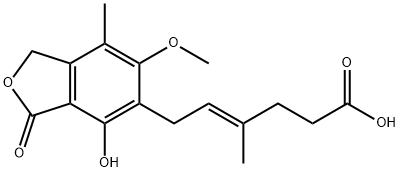Mycophenolic acid, less accurately called mycophenolate, is a compound derived from Penicillium stoloniferum and related species. It can reversibly inhibit inosine monophosphate dehydrogenase (IMPDH), the enzyme that controls the rate of synthesis of guanine monophosphate in the de novo pathway of purine synthesis used in the proliferation of B and T lymphocytes. Mycophenolic acid also has antibacterial, anticancer, antifungal, and antiviral activities. These powerful properties have been exploited in studies on organ transplant survival, anti-proliferative, rheumatoid arthritis, and psoriasis. It was initially marketed as the prodrug mycophenolate mofetil (MMF) to improve oral bioavailability. More recently, the salt mycophenolate sodium has also been introduced. Mycophenolate mofetil is marketed under the trade name CellCept and mycophenolate sodium as Myfortic.
Discovered by an Italian medical scientist Bartolomeo Gosio in 1893, mycophenolic acid was the first antibiotic to be synthesised in pure and crystalline form. But its medical application was forgotten until two American scientists C.L. Alsberg and O.M. Black resynthesised it in 1912, and gave its chemical name. It was eventually found to be a broad-spectrum acting drug having antiviral, antifungal, antibacterial, anticancer, and antipsoriasis properties. The clinically usable drug Cellcept was developed by South African geneticist Anthony Allison and his wife Elsie M. Eugui. It was first approved by the US Food and Drug Administration on 3 May 1995 for use in kidney transplantation.

